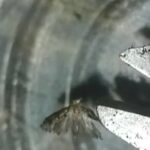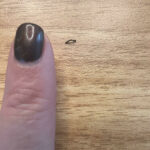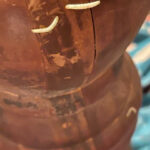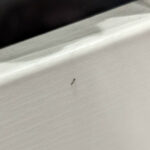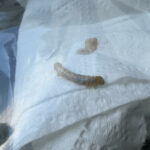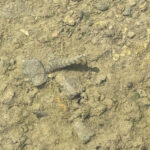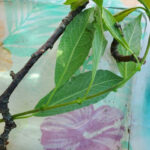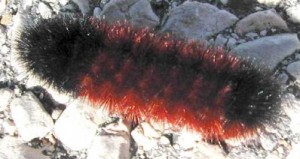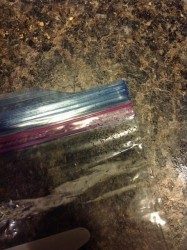The banded woolly bear caterpillar is the larva of the Isabella tiger moth. The banded woolly bear is black at both ends with a copper to brownish ring in the middle. The larva got its name due to its furry body. The banded woolly bear’s setae (bristles) are long, thick and fur-like. Although the setae may look dangerous, the banded woolly bear does not them for protection. In fact, the setae are not harmful at all. The banded woolly bear’s setae do not contain any venom and will not cause itching or stinging in normal skin. If you have very sensitive skin, however, the bristles, much like any other furry material, may cause itching or a rash. In general, handling the banded woolly bear caterpillar is discouraged, as it does not like to be handled.
While the banded woolly bear does not use its bristles for protection, it has another defense mechanism. If handled or threatened in any way, the banded woolly bear will simply play dead. You may think the woolly bear is asleep or dead, but its not. It’s just protecting itself from what it perceives as a threat. No matter what you do to “wake up” a banded woolly bear that is trying to protect itself, persisting will only make it try even harder to protect itself. It’s best to leave it alone and let nature take its course, meaning do not disturb the banded woolly bear while it is hibernating. It has to go through its natural stages to survive!
After the Isabella tiger moth lays its eggs, the banded woolly bear emerges in the fall. It remains in the caterpillar form during the winter. It produces a substance called “cryoprotectant” which protects it from the cold during the freezing winter months. As soon as the weather begins to warm up, the banded woolly bear emerges from its hibernation and immediately begins to feed. It typically feeds on any and all weeds or grass in its path. Once it has reached its fill, the woolly bear enters the non-feeding stage of its lifecycle called “pupate.” After it pupates, the banded woolly bear transforms into its adult form – the Isabella tiger moth (Pyrrhartica isabella). This usually happens in the late spring/early summer. The Isabella tiger moth lives through the summer, then the process repeats itself at the in the fall.
The Isabella tiger moth is equally as brilliant in color and appearance. It is yellow to orange in color and its wings are decorated with little black dots. The Isabella tiger moth also retains some of its “fur.” It has a furry thorax and a tiny head. The moth’s first pair of legs is a brilliant reddish-orange color.
It is believed that the amount of black on the banded woolly bears body predicts how severe the upcoming winter will be. This is, of course, common folklore as there is no scientific evidence to prove this. The eggs may vary in color from red to black, and once the eggs hatch to reveal the larva, the black bands may actually decrease in size as the larva grows.
In some states, the banded woolly bear is much like the groundhog. In the towns of Banner Elk, North Carolina; Beattyville Kentucky; and Vermilion, Ohio, banded woolly bear festivals are wildly popular.
All About Worms is always free, always reader-supported. Your tips via CashApp, Venmo, or Paypal are appreciated! Receipts will come from ISIPP Publishing.



